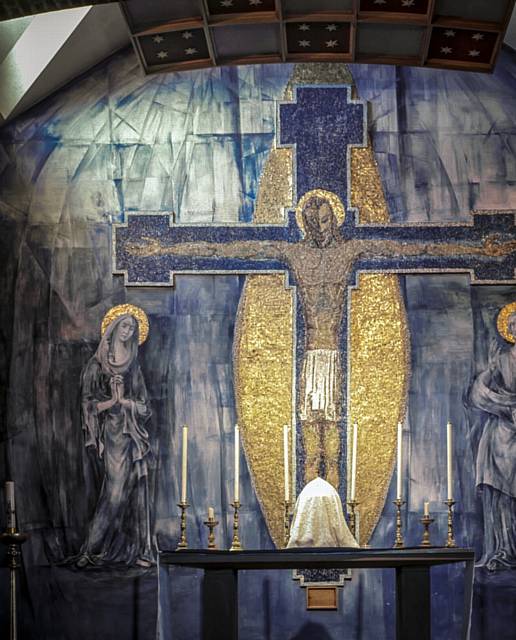Support growing to save unique mosaic
Reporter: Gillian Potts
Date published: 04 April 2017

THE mosaic created by Georg Mayer-Marton in the church
NATIONAL heritage campaigners are fighting to save a rare mosaic - created by a notable Jewish artist who fled Nazi persecution - displayed in Oldham's doomed Holy Rosary Church.
The Twentieth Century Society (also known as C20) has stepped in to help preserve what they describe as an "outstanding" 1950s mosaic of the crucifixion by Jewish refugee Georg Mayer-Marton, a leading figure in the Viennese art world in the 1920s and 1930s.
Historians and art experts have voiced serious concerns over the future of the eight-foot high piece, after the Fitton Hill church was deemed one of four to be closed as part of the Roman Catholic Church's reorganisation of the Diocese of Salford.
C20 is calling for Historic England to list the mosaic, which was completed in 1955 and is one of Mayer-Marton's most-significant and historically important works.
The Crucifixion mosaic was originally surrounded by wall paintings depicting the figures of Mary and John the Apostle against a background of various shades of blue.
Historical photographs show that the wall painting extended over the entire wall, but in the 1980s the fresco element was over-painted.
A recent technical report has concluded that it would be possible to uncover the original wall painting and to restore the work to its original conception. The mosaic element remains in good condition.
C20 senior conservation adviser Clare Price said: "The significance of this artwork lies not only in the high quality of its technique, but also as a rare example of post-war ecclesiastical art by a highly regarded artist."
Mayer-Marton - who was born in Hungary 1897 and died in Liverpool in 1960 - was one of Britain's very few experts in the art of face,or faceted, mosaic, with his work held in major collections.
Following the Anschluss of Hungary, he and his wife escaped to Britain in 1938. He worked as a lecturer for CEMA (the predecessor of Arts Council) until 1952, when he was appointed as a lecturer at the Liverpool College of Art. There, he established the Department of Mural Art.
He was commissioned by the Roman Catholic Church to carry out works at a number of churches in Lancashire and Cheshire.
Former parishioner of Holy Rosary Steve Haines has thrown all his efforts into securing the long-term future of the work.
Mr Haines, who now lives in Carrington, made contact with the great-nephew of the artist, Nick Braithwaite.
He said: "We fully support the action of the Twenty Century Society. Many art experts and members of the congregation have made representations to the Bishop of Salford, The Right Reverend John Arnold and by now he should be well aware of the value of the Church of the Holy Rosary. The application to Historic England is an important step to safeguard and eventually restore this masterpiece."
Mr Braithwaite added: "I am delighted that the Twentieth Century Society have made this listing application, reflecting their assessment of the importance of this unique work."




